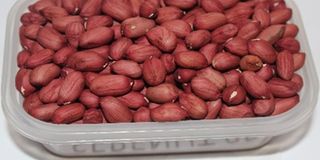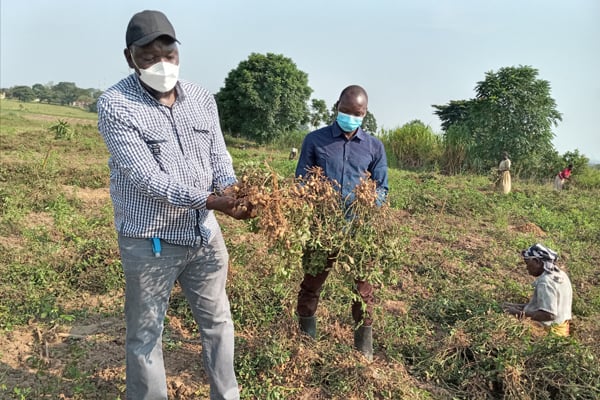Prime
New groundnut varieties to boost farmers’ income

Serenut 8R has superior characteristics with a large seed size and a yield potential of 2,500-3,700kg/ha. PHOTO | LOMINDA AFEDRARU
What you need to know:
- In order to boost the economic performance of groundnuts in Uganda, researchers are placing emphasis on relevant seed varieties farmers can adapt for sustained productivity amidst climate change. Key to this is continuous generation of quality seeds necessary to mitigate the adverse effects of emerging production challenges.
Agricultural scientists have been breeding groundnut varieties over the years and since 1996 have so far released 24 varieties out of which 14 have been approved to possess good attributes.
However, the ground breeding team is concerned that they have been conducting research while relying on interests of farmers minus considering market needs.
With groundnuts gaining ground on the commercial level as confectioneries use it for various value addition, attention is turning towards addressing consumption needs.
Importance
Groundnut, commonly also known as peanut, is the second most important legume after beans in Uganda. It is staple crop rich in protein, oil and essential minerals.
Groundnut is also a significant source of cash income contributing significantly to livelihoods of rural farmers while providing food security.
As a legume, groundnuts improve soil fertility by fixing nitrogen and thereby increase productivity of other crops in the cereal cropping systems. In terms of production, groundnut requires little input, making it appropriate for cultivation in low-input smallholding farming systems.
Traditionally, red Valencia type varieties ranging from large seeded to small seeded group such as red beauty are grown in Uganda.
Current efforts
Dr David Kalule Okello, the programme leader in charge of groundnut breeding at the National Semi-Arid Agricultural Resources Research Institute (NaSARRI) notes that the first person to industrialise ground is Diesel who processed diesel oil out of it in 1900 used in motor vehicles.
Okello has been instrumental in groundnut production in Uganda attributing 14 of the 24 varieties released to his efforts.
The red beauty was released in 1969 followed by Erudu variety which farmers are still growing with declining yields.
Groundnuts are exposed to pests and diseases that reduce yield and quality and increase the cost of
production wherever the crop is grown. This is in part due to climatic changes.
Therefore, scientists continue to breed varieties that can withstand common diseases such as groundnut rosette, early leaf spot, late leaf spot, rusts and aflatoxin.
In 2011, Dr Okello released the Serenut series 7-14 with most farmers preferring Serenut 8R, 14R and 9T.
By growing cultivars tolerant to certain diseases, researchers have been able to develop other breeding lines with resistance.

Growing improved groundnuts can boost farmers’ income. PHOTO | COURTESY
The current breeds under field trial to replace Serenut 8R and 14R as well as SGR 990400 which has relatively bigger seed, with a soft peel shell, high yield rate and a high oil content of 48 percent. Under good practices, it yields 3.5 tonnes per hectare. The second variety is SGVR 0805 which is being developed to replace the red beauty.
The current efforts are meant to make groundnut farming more profitable for the rural farmers.
Facing the challenge
The Director of NaSARRI Dr Michael Ugen explains that new breeds take into consideration current trends.
“Usually products developed out of a research process may along the way may loss resistance to certain pests and diseases, some may lose viability to drought. For the case of groundnuts, the Red beauty has succumbed to groundnut Rosset disease,” he notes.
The market-driven research agenda is supported by Bill and Melinda Gates Foundation through the International Maize and Wheat Improvement Centre (CIMMYT).
It is supporting researchers in various African countries to focus on the flour, oil content and the preferred red, tan or white colour, with a high oil content of more than 50 percent.
This arises from the fact that confectionaries prefer varieties with less oil yet those processing peanut butter require those with more oil content.
Dr Ugen says the primary role is to sensitise farmers to increase the acreage of groundnuts.
Currently, more than 413,000 acres of land are used for groundnut cultivation.
He challenges farmers to access quality seed from NaSARRI institute, farmer seed multiplication groups and seed companies.
Challenge
The scientists are faced with the challenge of the Rosset disease and pests such as termites, rodents and aphids, among others as well as aflatoxin. Researchers are now processing aflasafe from Atoxigen species to curb the challenge. This challenge is also being addressed by breeding varieties which have hard shells and good agronomy practices including post-harvest handling.
Good practices
On top of targeting the market needs, researchers are keen to minimise production losses by encouraging farmers to take up best management practices that will improve groundnut productivity and quality.
Recommended post-harvest practices
Timely harvesting is very important to avoid delays when ground nuts have reached maturity. Some non-dormant varieties such as Serenut 1R, Serenut 2, Serenut 3R, Serenut 4T, Serenut 6T can sprout in the field especially if it rains, thus splitting the pods allowing moulds to enter.
They recommend plucking the pods off the haulms and placed to dry as soon as possible to reduce chances of aflatoxins.
At harvest, care must be taken also to minimise mechanical damage.
Harvested pods should be placed on clean sheets, tarpaulins or raised structures.
Drying is aimed at taking the moisture content below 13 percent.
After shelling, dry groundnuts should be placed in an environment that restricts moisture pick-up or insect and rodent infestation.
Farmers can use gunny or polybags for storage.
Care should be taken to avoid mixing old and new stock.
Farmers and processors speak out
Mr Angelos Ochen groundnut farmer based in Lango sub-region, who doubles as the chairperson of Northern Uganda Local Seed Growers Association, notes that his group majors in producing various types of crop seed but with major focus on groundnuts.
But many farmers are frustrated because seed companies have not focused on processing ground nut seed.
The group has more than 150 members with 10 seed processors.
He says they usually purchase seed for multiplication from NaSARRI. A 100kg bag of unshelled seed is bought at Shs400,000. The 10 groups usually purchase 15 bags per season.
He normally plants groundnuts on eight acres which requires about 15 bags of unshelled seed for planting. In an acre, a farmer requires 44kg of unshelled seed and 23 shelled.
As seed multipliers, they complain of agriculture officials who delay to carry out inspection which prolongs the certification process of their seed.
For susan Okenyi, a peanut butter processor at Nakawa market notes that groundnut processing is a viable business.
Hailing from Karamoja, her husband who hails from Gulu introduced her in groundnut business since 1998 as senior four drop out.
She has managed to pursue education with Master’s in Business Administration and she is now an exporter across East Africa.
Groundnut is predominantly marketed in for of; unshelled pods, seed for propagation, groundnut powder, paste and shelled seeds.
However, she notes that Ugandan farmers are not producing enough groundnuts to meet the overwhelming demand. She says the market being substituted with groundnuts from Tanzania, Malawi, Zimbabwe and DR Congo
She urges more farmers to grow groundnuts on large scale to feed into the market.




